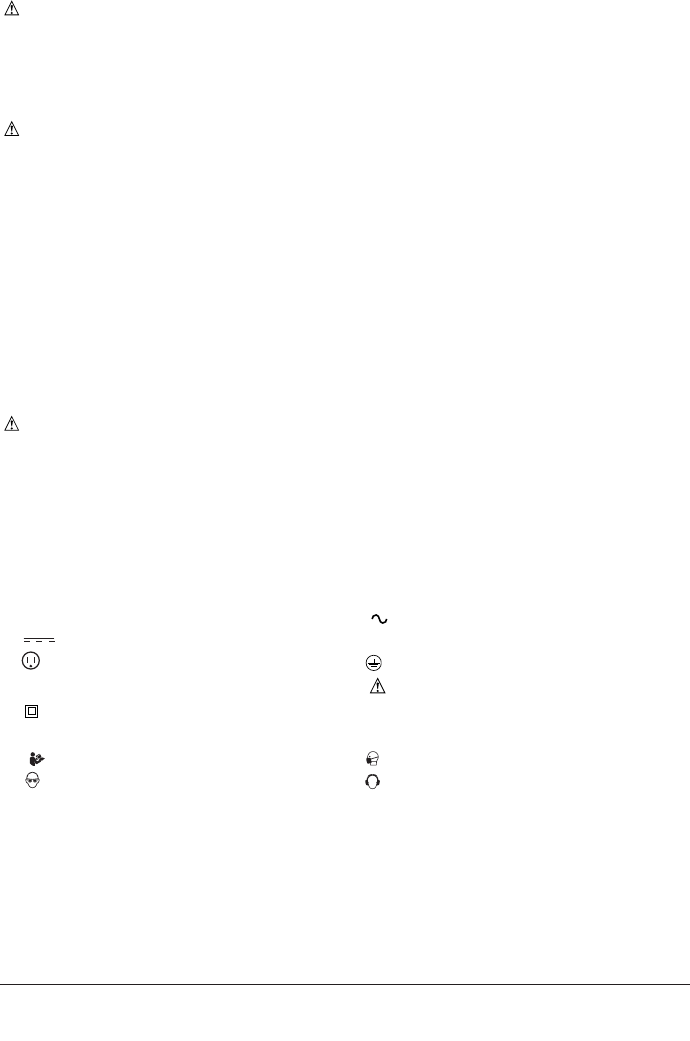
5
tripping or falling hazard. Some tools with large battery packs will stand upright but
may be easily knocked over.
Keep your hair, clothing, and gloves away from air vents. Air vents often cover
moving parts in which these items can be caught.
Hold tool firmly with two hands, one hand on the handle, and the other gripping the
bottom around the battery area or the auxiliary handle if provided. Loss of control can
cause personal injury.
WARNING: ALWAYS use safety glasses. Everyday eyeglasses are NOT safety
glasses. Also use face or dust mask if drilling operation is dusty. ALWAYS WEAR
CERTIFIED SAFETY EQUIPMENT:
• ANSI Z87.1 eye protection (CAN/CPA Z94.3),
• ANSI S12.6 (S3.19) hearing protection,
• NOSH/OSHA respiratory protection.
WARNING: Some dust created by power sanding, sawing, grinding, drilling,
and other construction activities contains chemicals known to the state of
California to cause cancer, birth defects or other reproductive harm. Some
examples of these chemicals are:
• lead from lead-based paints,
• crystalline silica from bricks and cement and other masonry products, and
• arsenic and chromium from chemically-treated lumber.
Your risk from these exposures varies, depending on how often you do this type of work.
To reduce your exposure to these chemicals: work in a well ventilated area, and work
with approved safety equipment, such as those dust masks that are specially designed
to filter out microscopic particles.
• Avoidprolongedcontactwithdustfrompowersanding,sawing,grinding,drilling,
and other construction activities. Wear protective clothing and wash exposed
areas with soap and water. Allowing dust to get into your mouth, eyes, or lay on the
skin may promote absorption of harmful chemicals.
WARNING: Use of this tool can generate and/or disperse dust, which may
cause serious and permanent respiratory or other injury. Always use NOSH/OSHA
approved respiratory protection appropriate for the dust exposure. Direct particles away
from face and body.
Symbols
definitions are as follows:
V .................. volts A ...................amperes
Hz ................ hertz W ..................watts
min ..............minutes
or AC .......alternating current
or DC ..direct current
n
o .................no load speed
................Class I Construction ..................earthing terminal
(grounded)
................safety alert symbol
................Class II Construction .../min or rpm...revolutions or
(double insulated) reciprocation per minute
............
Read instruction manual before use
..................Use proper respiratory protection
................Use proper eye protection ..................Use proper hearing protection
current your product will draw. An undersized cord will cause a drop in line voltage
resulting in loss of power and overheating. The following table shows the correct
size to use depending on cord length and nameplate ampere rating. If in doubt, use
the next heavier gage. The smaller the gage number, the heavier the cord.
Recommended Minimum Wire Size for Extension Cords
Total Length of Cord
25 ft. 50 ft. 75 ft. 100 ft. 125 ft. 150 ft. 175 ft.
7.6 m 15.2 m 22.9 m 30.5 m 38.1 m 45.7 m 53.3 m


















